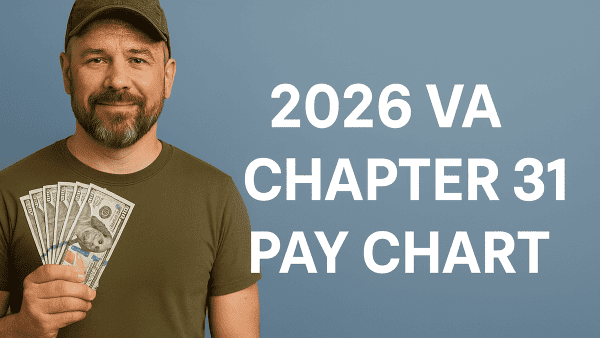Looking for Expert-Level VA Claim Answers?📱Call Us Now! 737-295-2226
The face of VA disability is changing — and it’s younger than ever. Gulf War and post-9/11 veterans, particularly those who served in the Global War on Terror (GWOT), now make up the majority of all VA disability recipients.
According to the VBA Annual Benefits Report, these veterans hold the highest average VA ratings, the most service-connected conditions, and the largest annual payouts of any era.
This post breaks down the latest VA disability statistics, what’s driving the shift toward Gulf War-era and post-9/11 veterans, and what these trends mean for your future VA claims.
Summary of Key Points
- Gulf War-era veterans (Aug. 2, 1990-present) are now the dominant group of all VA disability recipients at 61.4%.
- GWOT veterans average 9.26 rated conditions and VA disability compensation of $30,015 per year, the highest of any era.
- The top conditions of GWOT veterans are tinnitus, knee conditions, PTSD, and back/neck conditions, with more than 3.3 million claims combined. Burn pit presumptives also continue to drive claims.
- Post-9/11 growth: In FY2024, there were 457,919 new compensation recipients overall, including about 82,000 post-9/11 veterans, who accounted for around 18% of all new awards.
Table of Contents
The New Majority: Gulf War-Era Veterans Lead the Rolls
Of the 5,992,967 veterans receiving service-connected disability compensation at the end of FY2024:
- 3,678,404 are Gulf War-era veterans (Aug. 2, 1990-present), which is
- 61.4% of all compensated veterans, making it the single largest era group.
This includes both early Gulf War (1990–1991) and sustained post-9/11 operations. Within this group, GWOT veterans (service in Iraq, Afghanistan, or related theaters) stand out as the most complex cases.
Related Case Study: Air Force Veteran Wins 100% VA Rating After Years of Denials
Post-9/11 & GWOT Veteran Disability Data: High Volume, High Complexity

The GWOT subset includes 1,673,377 veterans, a rapidly growing segment with unique medical profiles:
- Average number of rated disabilities: 9.26 per veteran (highest of any era)
- Average annual VA disability compensation: $30,015 per veteran
- New recipients in FY2024: 457,919, with post-9/11 veterans accounting for approximately 18% of growth
These numbers reflect longer deployments, repeated combat exposure, and environmental hazards like burn pits, resulting in VA disability trends toward higher combined ratings and more presumptive conditions.
Related: Updated PACT Act Presumptive Conditions List
Average VA Disability Rating by Era: GWOT Tops the List
While exact combined VA ratings vary by individual, annual payment data in FY2024 reveal clear differences:
| Service Era | Recipients | Avg. Annual Payment | Implied Rating Range** |
| GWOT (post-9/11) | 1,673,377 | $30,015 | 90%–100% |
| All Gulf War Era | 3,678,404 | $27,517 | 90% |
| Vietnam Era | 1,403,881 | $25,080 | 80%-90% |
| Pre-Vietnam (WWII + Korean) | 58,500 | $16,741 | 50%–60% |
**Estimated using VA’s compensation pay tables. GWOT veterans’ $30,015 average suggests most hold 80% to 100% combined ratings, fueled by multiple overlapping conditions.
Common Disabilities for Veterans: GWOT’s Top Four
GWOT veterans experience a range of service-connected conditions. The top four are:
- Tinnitus: 1,039,663 recipients
- Knee conditions: 894,994
- PTSD: 714,245
These reflect blast exposure, heavy gear loads, combat stress, and long-term wear from multiple deployments. Many GWOT veterans also qualify under the PACT Act for respiratory, cancer, and Gulf War Illness presumptives.
Related: 7 Common Questions About MUCMI (Medically Unexplained Chronic Multisymptom Illnesses)
VA Compensation Statistics: The Big Picture
- Total compensation paid: $163.1 billion
- Gulf War Era share: $93.5 billion (approximately), or 61.4% of total
- New GWOT claims: Driving more than 90% of annual growth
- Fiduciary support: 101,155 beneficiaries needed oversight, many with severe mental health or cognitive impairments
Conclusion
VA disability statistics no longer belong to Vietnam or Korean War veterans; it’s the era of Gulf War and post-9/11 veterans. With 3.7 million Gulf War-era recipients, 1.67 million GWOT veterans, and more than nine conditions on average, the system is adapting to a new generation of complex claims.
If you served after 1990, your service is likely to have had lasting impacts. File now; the data proves you’re not alone.
Want Expert-Level Support for Your VA Disability Claim?

- VA Claims Insider is the #1 most trusted name in VA disability claims.
- Work directly with a VA claims coach who can educate you through the claims process.
- 25,000+ disabled veterans have served in our membership programs since 2016.
- 30% average rating increase for veterans who complete our #1-rated Elite program.
FAQs | Frequently Asked Questions
How many GWOT veterans get VA disability?
There are more than 1,673,377 GWOT veterans (Gulf War-era and post-9/11) who currently receive VA disability, and that number continues to grow.
What’s the average VA disability payment for post-9/11 Veterans?
The average VA disability payment for post-9/11 veterans is $30,015 per year, reflecting combined ratings from multiple conditions.
Are tinnitus and PTSD the most common claims?
Yes. For GWOT-era veterans, the most common claims are tinnitus, with 1,039,663 recipients, followed by knee conditions and PTSD at 714,245.
What percentage of Americans are 100% disabled veterans?
According to the VA disability statistics in the annual VBA report, 100% disabled veterans make up about 25% of all disabled veterans. The U.S. population is currently around 340 million, making the approximately 1.6 million 100% disabled veterans about 0.005% of the total U.S. population.
What is the VA 5-year rule?
The “5-year rule” refers to a VA-compensated disability that hasn’t shown improvement in five years; after that time, the condition is considered “stabilized,” and the VA generally won’t reduce benefits. Related: VA Disability 5-year Rule

Katie McCarthy
Katie McCarthy is a writer and editor with experience in daily news and digital and print magazine publishing. She honed her editorial (and firearms) skills at Guns & Ammo before helping launch Black Rifle Coffee Company’s Coffee or Die Magazine as the managing editor. She holds degrees in English (BA) and public administration (MPA). Katie is a military spouse and word nerd who enjoys reading, hiking, camping, gardening, and spending time with her family.

Quality Assurance Team
The Quality Assurance (QA) team at VA Claims Insider has extensive experience researching, fact-checking, and ensuring accuracy in all produced content. The QA team consists of individuals with specialized knowledge in the VA disability claims adjudication processes, laws and regulations, and they understand the needs of our target audience. Any changes or suggestions the QA team makes are thoroughly reviewed and incorporated into the content by our writers and creators.



